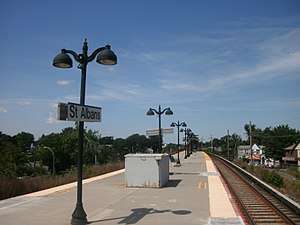St. Albans station (LIRR)
St. Albans is a station on the Long Island Rail Road's Montauk Branch in the St. Albans neighborhood of Queens, New York City. It is located on the southwest corner of Linden Boulevard and Montauk Place, although the segment of Montauk Place that once intersected with Linden Boulevard has been abandoned and fenced off.
St. Albans | ||||||||||||||||||||||||
|---|---|---|---|---|---|---|---|---|---|---|---|---|---|---|---|---|---|---|---|---|---|---|---|---|
 The St. Albans station platform. | ||||||||||||||||||||||||
| Location | Linden Boulevard and Montauk Place St. Albans, Queens, New York | |||||||||||||||||||||||
| Coordinates | 40.691052°N 73.765426°W | |||||||||||||||||||||||
| Owned by | Long Island Rail Road | |||||||||||||||||||||||
| Line(s) | Montauk Branch | |||||||||||||||||||||||
| Platforms | 1 island platform | |||||||||||||||||||||||
| Tracks | 2 | |||||||||||||||||||||||
| Connections | ||||||||||||||||||||||||
| Other information | ||||||||||||||||||||||||
| Fare zone | 3 | |||||||||||||||||||||||
| History | ||||||||||||||||||||||||
| Opened | July 1, 1898[1] | |||||||||||||||||||||||
| Rebuilt | 1935 | |||||||||||||||||||||||
| Electrified | May 21, 1925 750 V (DC) third rail | |||||||||||||||||||||||
| Previous names | Locust Avenue | |||||||||||||||||||||||
| Traffic | ||||||||||||||||||||||||
| Passengers (2012—2014) | 461[2] | |||||||||||||||||||||||
| Rank | 99 of 125 | |||||||||||||||||||||||
| Services | ||||||||||||||||||||||||
| ||||||||||||||||||||||||
| Former services | ||||||||||||||||||||||||
| ||||||||||||||||||||||||
The station is served by some Babylon Branch trains and all West Hempstead Branch trains on weekdays. It is one stop east of Jamaica station, which provides access to nearly all other LIRR services.
History
In 1872, the Long Island Rail Road's Cedarhurst Cut-off was built through the area, but no stop appears here on the first timetables.[3] Saint Albans Station was built on July 1, 1898, and originally appeared on maps with the name of Locust Avenue (the same name as the station at the other end of what is now called Baisley Boulevard).[4] The station was razed in 1935 as part of a grade elimination project.[5] The current elevated structure was opened either on October 22 or October 23, 1935.
Station layout
This station has one narrow six-car-long island platform between the two tracks with two entrances. The north staircase goes down to the south side of Linden Boulevard between Newburg and 180th Street while the south staircase goes down to a short tunnel leading to the dead-end street of Foch Boulevard.
| P Platform level |
Track 1 | ← Montauk Branch does not stop here ← Babylon Branch toward Jamaica, Atlantic Terminal, or Penn Station (Jamaica) ← West Hempstead Branch weekdays toward Jamaica, Atlantic Terminal, or Penn Station (Jamaica) |
| Island platform, doors will open on the left | ||
| Track 2 | West Hempstead Branch weekdays toward West Hempstead (Westwood) → Babylon Branch toward Babylon (Lynbrook or Rockville Centre) → Montauk Branch does not stop here → | |
| G | Ground level | Entrance/exit, parking, buses |
Service
Although this station is listed on the West Hempstead Branch timetable only, most service is provided by Babylon Branch trains. Approximately 226 trains stop here per week, with only four weekday morning peak trains from West Hempstead serving this station, while hourly Babylon trains serve it daily from about 6:00 AM to 11:00 PM during off peak periods. Babylon Branch trains also serve the station bihourly on weekends. The station sees no late night service.
The station is within Zone 3 and the boundaries of the CityTicket program.
References
- Long Island Railroad Station History (TrainsAreFun.com) Archived 2011-01-06 at the Wayback Machine
- "2012-2014 LIRR Origin and Destination Report : Volume I: Travel Behavior Among All LIRR Passengers" (PDF). Metropolitan Transportation Authority. August 23, 2016. PDF pp. 15, 199. Archived (PDF) from the original on July 17, 2019. Retrieved March 29, 2020.
Data collection took place after the pretest determinations, starting in September 2012 and concluding in May 2014. .... 2012-2014 LIRR O[rigin and ]D[estination] COUNTS: WEEKDAY East/West Total By Station in Numerical Order
- "Cedarhusrt Cutoff - ARRT'S ARRCHIVES".
- "1898 map showing Locust Ave station in St. Albans on the Rockaway Branch of the LIRR" (JPG). (Locust Avenue is now called Baisley Boulevard)
- "St.Albans Station photos".(Schedule on this page indicates trains stopped as early as 1897)